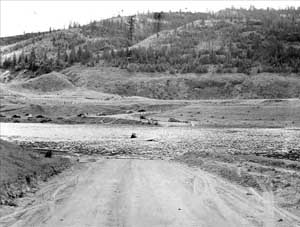On December 15, 1941, the International Joint Commission, which oversees boundary waters issues between Canada and the United States, approves an application for the Grand Coulee Dam. This is a formality, since the dam is already finished and the generators have been running for months. The commission does not have the authority to say yes or no to the dam, but does have authority to address issues that might change the Columbia River's water levels at the international border. At public hearings in Spokane and in Trail, B.C., engineers and investigators report that in some high-water situations, the dam's reservoir, Lake Roosevelt, might barely reach the Canadian border. However, they report that the U.S. is blasting a larger pool at the Little Dalles, 15 miles downstream, which will prevent the backup from reaching the border. Citizens ask about the impact of the dam on salmon and are told that the loss of the salmon runs will be mitigated by the construction of trout hatcheries.
A Matter of Form
The International Joint Commission consisted of three members appointed by the U.S. and three appointed by Canada. It had been created under the terms of the 1909 Boundary Waters Treaty governing border waterways to rule on activities, including dams, that have cross-border impacts.
In September 1940, the U.S. government applied to the commission for approval to construct the Grand Coulee Dam project "in order that the matter may be beyond controversy" (Harrison, "International Joint Commission"). The dam was virtually finished (work had begun in 1934); approval was strictly a matter of form.
The commission's investigation and hearings largely dealt with the issue that prompted the U.S. to belatedly apply for approval: the possibility that water might, in some circumstances, back all the way over the international border. The U.S. conceded that the dam "might moderately" increase water levels at the border, despite the fact that the Grand Coulee Dam was 150 miles downstream.
Final Ruling and More Studies
Engineers reported that U.S. authorities were blasting a larger pool for the reservoir at the Little Dalles, 15 miles south of the border, to reduce further even the small chance that any flooding would occur across the border in Canada. About 300,000 cubic yards of rock were being removed at Little Dalles.
A few citizens at the hearings raised the issue of the loss of salmon and steelhead runs into Canada -- indeed, into every part of the Columbia system upstream of the Grand Coulee Dam. Dam officials told them that the salmon and steelhead would be replaced by trout from big new hatcheries, "the liveliest rainbows in the United States" (Harrison, "International Joint Commission").
The International Joint Commission's final ruling came as no surprise. It approved the Grand Coulee Dam project, reserving the right to revisit the issue if the Little Dalles excavation proved inadequate. In 1944, the commission launched a series of larger studies over much more complex issues of water storage, power generation, and flood control on the Columbia. These studies eventually led to the Columbia River Treaty, ratified in 1964, which began a new era of U.S.-Canada cooperation in managing the Columbia River.

